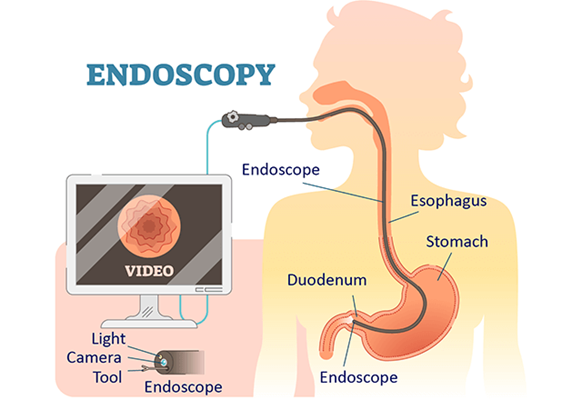
AnEndoscopyis a procedure where the surgeon uses specialized instruments to examine and operate on the bodys internal organs and vessels. It helps doctors to see issues inside the body without making large incisions. A surgeon inserts an endoscope through a small cut or a natural opening in the body. An endoscope is a flexible tube with a camera attached to it that lets your doctor see. Your doctor can control forceps and scissors at the end of the endoscope, to performBiopsyoperations.

For example, doctors use a type ofEndoscopyto test colorectal cancer, called a colonoscopy. Your doctor may remove growths, called polyps, during a colonoscopy. Without removal, polyps may lead to cancer.
The type ofEndoscopyrecommended by your doctor is dependent on the part of the body being examined.
Doctors use endoscopes for certain treatments. Treatments possibly involving an endoscope include:
The doctor will confirm the symptoms, do a physical exam, and probably orderBlood TestsbeforeEndoscopy. Such assessments will help your physician gain a greater understanding of the potential cause of your symptoms. These tests may also help them determine whether they can treat the problems withoutEndoscopyorSurgery.
The doctor puts the endoscope into your mouth. He or she can ask you to swallow, as the scope passes through your throat. You may feel some pressure in your throat but you do not necessarily experiencePain. Once the endoscope passes your throat you cannot speak, but you can make noises. The endoscope should not mess with the respiration.
A small camera at the tip transmits pictures to the video display. Your doctor will watch the monitor look into your digestive tract for abnormalities. If there are abnormalities in your digestive tract, your doctor can record pictures for subsequent tests. Gentle air pressure can be injected into the esophagus to inflate the digestive tract. This allows free movement of the endoscope. It helps the doctor to inspect the folds of the digestive tract more easily. Your doctor can pass special surgical equipment through the endoscope to retrieve a tissue sample or remove a polyp, if necessary. Your doctor will use the video display to direct and control the devices. The endoscope is slowly retracted through your mouth after your doctor has finished the exam. Depending on the case, anEndoscopyusually requires about 15 to 30 minutes.
Endoscopies are categorized based on the area of the body that they investigate. The American Cancer Society (ACS) has categorized the following types of endoscopies:
| Name of procedure | Name of Scope | Area or organ examined | Route of Insertion |
| Anoscopy | Anoscope | Anus and / or rectum | Through the anus |
| Arthroscopy | Arthroscope | Joints | Through a small incision over the joint |
| Bronchoscopy | Bronchoscope | Trachea, or windpipe, and the lungs | Through the mouth |
| Colonoscopy | Colonoscope | Entire length of the colon and large intestine | Through the anus |
| Colonoscopy | Colonoscope | Vagina and cervix | Not inserted. Placed at the vaginal opening |
| Cystoscopy | Cystoscope | Inside of the bladder | Through the urethra |
| Esophagoscopy | Esophagoscope | Esophagus | Through the mouth |
| Gastroscopy | Gastroscope | Stomach and duodenum, which is the beginning of the small intestine | Through the mouth |
| Laparoscopy | Laparoscope | Stomach, liver, or other abdominal organs, female reproductive organs | Through a small, surgical opening in the abdomen, including the uterus, ovaries, and fallopian tubes |
| Laryngoscopy | Laryngoscope | Larynx, or voice box | Through the mouth |
| Neuroendoscopy | Neuroendoscope | Areas of the brain | Through a small incision in the skull |
| Proctoscopy | Proctoscope | Rectum and sigmoid colon, which is the bottom part of the colon | Through the anus |
| Sigmoidoscopy | Sigmoidoscope | Sigmoid colon | Through the anus |
| Thoracoscopy | Thoracoscope | Pleura, which are the 2 membranes covering the lungs | Through a small surgical opening in the chest and lining the chest cavity, and structures covering the heart |
Endoscopy poses a much lower risk of bleeding and infection compared with openSurgery. However, it is a medical procedure, so there is some risk of bleeding, infection, and other rare complications like: